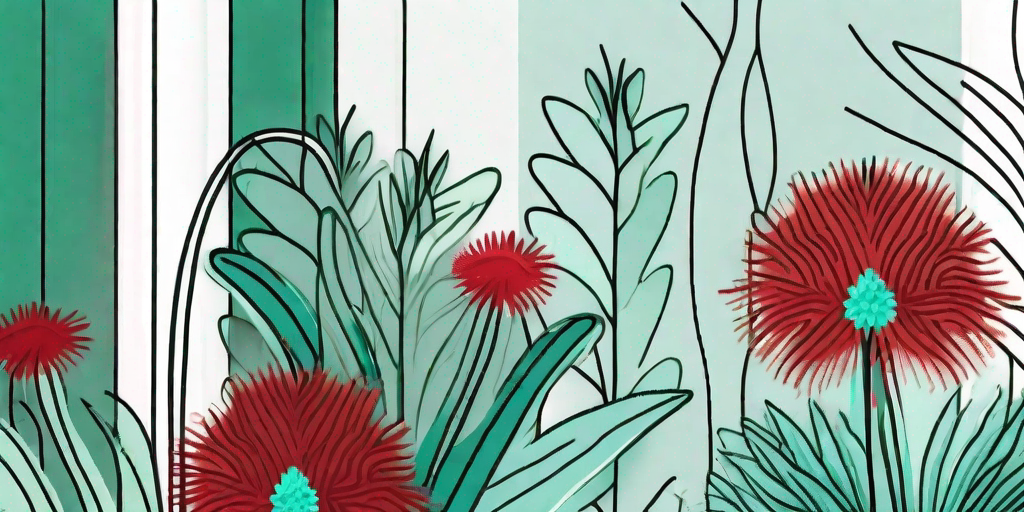
Welcome to the world of indoor gardening, where the green is greener and the fuzzy is fuzzier. If you're a fan of the fluffy, then you're in the right place. We're about to introduce you to the Chenille Plant, a fuzzy addition to your indoor garden that's as cozy as your favorite sweater.
Meet the Chenille Plant
Before we dive into the nitty-gritty of caring for this fuzzy friend, let's get to know it a bit better. The Chenille Plant, also known as Acalypha hispida, is a tropical shrub that's known for its long, fuzzy, red flowers. These flowers, which are often compared to fuzzy caterpillars, are where the plant gets its common name. 'Chenille' is French for caterpillar, and we must admit, the resemblance is uncanny.
Native to the Pacific Islands, the Chenille Plant thrives in warm, humid conditions. But don't let its tropical origins scare you off. This plant is surprisingly adaptable and can thrive in your indoor garden with a little bit of love and care.
What Does the Chenille Plant Look Like?
The Chenille Plant is a sight to behold. Its glossy, dark green leaves provide a stunning contrast to its bright red, fuzzy flowers. The flowers, which can grow up to 18 inches long, hang down from the plant like fuzzy, red dreadlocks. It's a unique look that's sure to turn heads and spark conversations.
But the Chenille Plant isn't just about looks. It's also a fast grower. With the right care, your Chenille Plant can grow up to 6 feet tall. That's a whole lot of fuzzy goodness!
Caring for Your Chenille Plant
Now that you're familiar with the Chenille Plant, let's talk about how to care for it. Don't worry, it's not as complicated as it sounds. In fact, with a few simple steps, you can keep your Chenille Plant happy and healthy.
First things first, the Chenille Plant loves the sun. So, make sure to place it in a spot where it can get plenty of bright, indirect light. But be careful not to expose it to direct sunlight, as this can scorch its leaves.
Watering and Feeding
The Chenille Plant likes to stay moist, but not too wet. So, water it regularly, but make sure the soil drains well to prevent waterlogging. As for feeding, a balanced liquid fertilizer every two weeks during the growing season should do the trick.
Remember, the Chenille Plant is a tropical plant, so it loves humidity. Regular misting can help keep the humidity levels up. But if you live in a dry climate, you might want to consider getting a humidifier.
Pruning and Repotting
As we mentioned earlier, the Chenille Plant is a fast grower. This means you'll need to prune it regularly to keep it in shape. Don't be afraid to give it a good trim. This will encourage bushier growth and more flowers.
Repotting should be done every two years or so. This will give your Chenille Plant more room to grow and ensure it gets the nutrients it needs. When repotting, make sure to use a pot with good drainage and a well-draining soil mix.
Common Problems and How to Solve Them
Like all plants, the Chenille Plant can encounter a few problems. But don't fret, most of these issues are easy to solve.
Yellow Leaves
If your Chenille Plant's leaves are turning yellow, it could be a sign of overwatering. Cut back on the watering and make sure the soil is well-draining.
Brown Tips
Brown tips on the leaves could indicate a lack of humidity. Try misting your plant more often or consider getting a humidifier.
No Flowers
If your Chenille Plant isn't flowering, it might not be getting enough light. Move it to a brighter spot, but remember to avoid direct sunlight.
FAQs
Is the Chenille Plant Toxic?
Yes, the Chenille Plant is toxic to pets and humans if ingested. So, keep it out of reach of curious pets and children.
Can the Chenille Plant Grow Outdoors?
Yes, the Chenille Plant can grow outdoors in USDA zones 10 and 11. However, it's best grown as a houseplant in most climates.
How Often Should I Water My Chenille Plant?
Water your Chenille Plant when the top inch of soil feels dry. But remember, it's better to underwater than overwater.
Conclusion
There you have it, everything you need to know about the Chenille Plant. This fuzzy friend is a unique addition to any indoor garden. With its stunning looks and easy care, it's sure to become a favorite. So, why not get cozy with the Chenille Plant? Your indoor garden will thank you.















